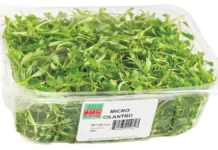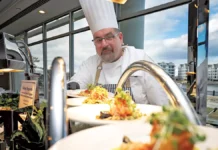Derived from the Hindi word meaning passion, Michelin Star rated Junoon Restaurant delivers on the promise of its moniker with an authentic, yet elegantly modern take on Indian cuisine. With a talented team, including Executive Chef and cookbook author Vikas Khanna to Junoon’s Wine Director and General Manager, Guy Goldstein, both have helped create a dining experience to satisfy all aspects of fine cuisine: wine selection, service, ambience and atmosphere.
From a menu which reflects the diversity of India, steeped in the classics while offering deft touches of modernity to a wine program constructed of over 750 bottles spanning both the “old world” and “new world.” Total Food Service sat down with Chef Vikas and Guy Goldstein to discuss their roles on menu and wine strategies at Junoon.
 Chef Vikas Khanna
Chef Vikas Khanna
Chef Vikas, to those who may not know you, give us a little background about yourself and how did you land at Junoon.
At a very young age I got interested in cooking learning from my grandmother and mother. After I finished my culinary training in India I came to the US where I got my first job at an Indian restaurant. A year later I met Restaurateur Rajesh Bhardwaj who shared his vision of Junoon with me and immediately I knew this is something for me and since then I started working with him.
Junoon’s menu seasonally focuses on the five elements of Indian cooking. Explain the menu change process and how the five elements on Indian cooking play a crucial role in your offerings.
We wanted to do something different and introduce the ancient art of sigri (open spit fire) Tawa (griddle cooking) and Patthar (stone cooking) which no other restaurant did. So we had the menu around these cooking techniques besides having regional dishes.
We change our menu seasonally to use the freshest ingredients available to us.
Does the menu reflect cuisine where you grew up in India or do you craft dishes from the many renowned culinary regions in India?
It does have some dished from the region where I grew up but we have dishes from different regions of the country.
You’re known for compelling creativity, do you try to stay as authentic as possible or do you put a non-traditional spin on your dishes?
Our motto here is to stay as traditional as possible for flavor and taste to create authentic dishes. But we do apply nontraditional techniques to our cooking process to get the best out of it. Also a lot of effort goes in the plating and presentation of the dishes where there is a nontraditional spin.
Utilize any organically farmed seasonal produce from local farms?
When we can source local organic ingredients that suit our cuisine and current menu we absolutely do so. You will find seasonality represented mostly in our vegetarian dishes and garnishing. It is always our goal to support the local farming community of New York and the surrounding states.
Rajesh Bhardwaj offers dishes rarely seen in the U.S such as Anari Chooza (Free-Range Cornish game hen, pomegranate seeds, roasted cumin seeds and mace.) What’s the thinking behind this and why don’t we see these types of dishes at other Indian restaurants?
This was our version of the famous Tandoori Chicken. Almost every Indian restaurant does a Tandoori chicken (marinated and cooked in the clay oven) we wanted to create something new and different hence this dish was born. Most of the chefs do stay focused on age old traditional dishes but we want to constantly challenge ourselves and see if we can deconstruct a traditional dish and then reconstruct it differently for an enhanced experience.
On the equipment side, what’s one piece of equipment that makes your job easier preparing dishes at Junoon?
There is not one particular equipment which I like to use. I always like to experiment with new ingredients and techniques so to me all the five elements are equally important.
The restaurant industry has a very broad range of foods…what’s your buying approach? Do you go out to bid on a regular basis or do you look for loyalty from vendors?
We do work with many that we have long-term relationships with, especially for some hard to find ingredients. We buy our spices in bulk to get them as fresh as possible. This is so we can grind and blend them ourselves. Good business is all about good relationships and we rely on our vendors just as they rely on us. We are always interested in finding a superior product, especially if we can get it at a value that we can pass along to our guests.
 Guy Goldstein
Guy Goldstein
I joined the Junoon team as the General Manager after 18 years of New York City restaurant experience in a variety of cuisines and styles. As both an educator for the American Sommelier Association and an avid oenophile, I was eager to oversee the development of Junoon’s award winning wine program in the capacity of Operating Beverage Director.
Some Indian restaurants choose not to offer alcoholic beverages and if they do, it’s very limited. Junoon on the other hand has a wine list consisting over 750 bottles and not to mention a handcrafted cocktail program. How important is the wine and cocktail program to Junoon’s bottom line?
It is true that our cuisine is not commonly thought to be wine friendly and, as with any restaurant, some of our guests may not consume alcohol. Despite this misconception that Indian cuisine cannot be paired with great wine and cocktails just as artfully as with any other cuisine, at Junoon we have found that many of our patrons are eager to take full advantage of our 750 wine selections and food and wine pairings.
We have meticulously composed programs to both compliment and elevate our cuisine and overall dining experience. We wanted to offer a wine program that is among the best in the city and a cocktail program that is innovative and fine-tuned to enhance and brighten our menu. As a pillar of Junoon’s vision, the wine and cocktail program certainly plays an important role in our bottom line.
How do you choose wines designed to harmonize with the spices and complexities to match Junoon’s cuisine? And what regions are you sourcing your wines from?
We consistently test new food and wine pairings. Since our menu encourages “family-style” dining, we must consider the variety of dishes on the table in addition to the individual plates. Many spice blends, peppers and marinades offer a depth of complexities to play with, allows us to use bigger bolder wines that are often thought to be too powerful to pair with fine food. The wines that we have identified that best suit our cuisine typically come from the Rhone Valley, Burgundy, the Right Bank of Bordeaux, and California for both red and white varietals.
Of course the standards of Riesling, Gewürztraminer and Sparkling wine represent a strong content of the program as well. At the same time, we prominently feature Southern Hemisphere reds and whites. We have so far discovered two successful approaches to pairing our cuisine. The first is to heighten and accentuate the spice and heat with aromatic, fruit-driven, medium to full-bodied whites and reds. The second is to balance the heat and spice with semi-sweet to sweet whites and full-bodied rich reds. My favorite is pairing with older Rhone reds where we compliment the spices with deep complex earth tones and primary and secondary fruits; the tannin has integrated into the wine, making a perfect marriage of complex food and wine.
Abrupt, or even subtle, changes in storage temperatures can dramatically affect the quality of wine. What steps do you take to make sure your wines are precisely controlled?
We have two wine cellars in the restaurant capable of holding well over 10,000 bottles; a display cellar in the Main Dining Room and a storage cellar in the basement of the restaurant. Both cellars are temperature and humidity controlled, maintaining storage at 58 degrees with 70 percent humidity.
What do you think is the most versatile wine and do you have any preferences for New World versus Old World wines?
Choosing one particular wine as a finished product is difficult, however certain varietals are naturally more versatile and allow for a wide range of expressions. One would be Riesling, offering everything from the bone-dry Alsatians to the unctuously sweet, nectar-like Sélections de Grains Nobles and German Eisweins. Another varietal would be the renowned Chenin Blanc of the Loire Valley, which manifests itself as highly acidic and dry in Savennières and delectably sweet in Bonnezeaux. While I personally tend to prefer French wines, I will ultimately choose a wine – whether Old or New World – according to what the food demands, and I am always eager to discover new up-and-coming wine makers regardless of their origin.
A 750 wine list can be a little frightening for a novice. Is Junoon’s wine program built for a wine enthusiast?
Our 750 titles undoubtedly make Junoon a destination for our wine-savvy guests. While we fully understand that such a large selection may be intimidating for some of our guests, the Junoon team (including 6 certified sommeliers) is prepared to expertly guide these guests through their selection process and hone in on their individual preferences. Also, our by the glass list is very intentionally designed to feature wines that complement our cuisine and serve as a general guideline. One of the many benefits of having such a large selection is that we are able to offer both the big-name Bordeaux and Burgundy classics as well as some beautifully made, lower priced, or lesser known wines.
You need to know that your staff is knowledgeable about each type of wine on your list. How do you train and teach your staff?
Rigorous training. At Junoon, we pride ourselves on having a staff that is extremely well versed not only in our cuisine, but also in wine, cocktails, and pairing. To maintain this level of knowledge, we offer our staff a full range of resources including wine and food tastings, regularly scheduled classes with examinations, and incentives to build their knowledge independently – sommelier certification among others.
Consumers are savvier about wine markups more than ever and wine is a commodity. The nicer the restaurant, the higher the cost. How do you price your wine list and what’s your buying approach?
As far as purchasing wine for the restaurant is concerned, I am always looking to fortify our list with some of the rare, limited production wines, including the classic Bordeaux and Burgundys that are well worth the higher cost. At the same time, the market is saturated with beautifully made, under-valued, and unnoticed wines that allow me to pass along their great value to our guests. I am a huge proponent of featuring $50 bottles that taste like $100 bottles. It is also not uncommon to offer wines not available to the general public. This requires a large initial investment to purchase the wine upon its release, but pays off ten-fold once the wine has fully matured and reached its ideal level of drinkability.























